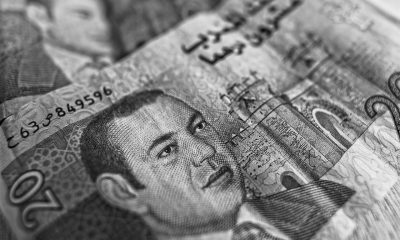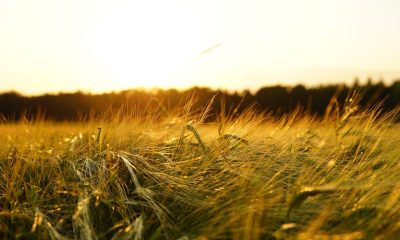Africa
The Economic Situation in Morocco: Domestic Demand Continues to Recover
Domestic demand in Morocco continued to recover in Q2-2021. According to the HCP, household consumption has, in fact, strengthened by 18.9% instead of 2.4% in Q1. It was driven in particular by an increase in purchases of foodstuffs, manufactured goods and transport, catering and leisure services. General government consumption rose by 5.3%, compared with 6.2% in Q1.

After a contraction of 6% in 2020, domestic demand, which is an important lever of economic growth, has gradually started to recover. In the first quarter of 2021, it grew by 3.5%. The dynamics continued in the second quarter of 2021 where household consumption has strengthened by 18.9% and according to the HCP, which revealed these data, household consumption should end the current year at 3.1% in volume with a contribution to the economic growth of 1.8 points.
Read more on the subject and find the latest economic news from around the world with the Born2Invest mobile app.
The optimism of households and businesses is increasingly back, since the beginning of the year
According to the High Commission for Planning (HCP), which states in its note on the economic situation in 2021 and its prospects in 2022, this trend is the result of the control of the pandemic situation and the smooth running of the vaccination campaign. In any case, it is already reflected in the recovery of domestic demand, which had fallen sharply last year in the midst of the health crisis.
As a reminder, domestic demand contracted by 6% in 2020, instead of increasing by 1.7% a year earlier, with a negative contribution to growth of 6.5 points. Household final consumption expenditure fell by 4.1% in 2019 instead of rising by 1.9%, with a negative contribution to growth of 2.3 points compared with a positive contribution of 1.1 points. Gross investment (gross fixed capital formation and change in inventories), for its part, recorded a sharp decline in its rate of growth, from -0.4% in 2019 to -14.2% in 2020, with a contribution to growth of -4.6 points instead of -0.1 point. The only exception was final consumption by general government, which posted a positive growth rate of 1.7% in 2020 instead of 4.7% a year earlier, with a contribution to growth of 0.3 points instead of 0.9 points. In short, since the beginning of this year, things have gradually started to change.
Growth of 3.5% in Q1-2021
Domestic demand has, in fact, increased by 3.5% in the first quarter of 2021 instead of 0.1% in the same period of 2020. According to the HCP, which reported in its briefing note on the national economic situation in Q1-2021, this demand has contributed for 3.8 points to national economic growth instead of 0.2 point. In this context, the final consumption expenditure of households has increased by 2.4%, contributing for 1.5 point to growth, said the same source, adding that the final consumption of government has shown an increase of 6.2%, with a contribution to growth of 1.3 point.
Gross investment, for its part, recorded an increase of 4.1%, with a contribution to growth of 1 point. On the other hand, the HCP noted that foreign trade in goods and services made a negative contribution to growth, standing at -2.8 points instead of a positive contribution of 0.7 points in the same quarter of the previous year. Exports fell by 10.8% in Q1-2021 with a negative contribution to growth of 3.9 points, while imports of goods and services fell by 2.5% (positive contribution of 1.1 points).
Household consumption up 18.9% in Q2-2021
It should be noted that despite this false note, domestic demand has continued to recover in Q2-2021. According to the HCP, household consumption has, in fact, strengthened by 18.9% instead of 2.4% in Q1. It was driven in particular by an increase in purchases of foodstuffs, manufactured goods and transport, catering and leisure services. General government consumption rose by 5.3%, compared with 6.2% in Q1, in line with the increase in administrative operating expenditure. Gross capital formation (GCF) also continued the upward trend that began at the start of the current year, increasing by 5.5% compared with the previous year.
The investment effort had thus been maintained for the capital goods and manufactured, in a context of recovery of the local demand and dissipation of the difficulties of supply particularly from outside. Imports of capital goods have increased by nearly 50%, during the two months of April and May 2021. Investment in construction has also continued its upward trend, benefiting from the recovery in real estate demand and supply in a context of a 4.4% increase in real estate loans, at the end of May 2021.
Yet inflation rose by 1.7 percent
Yet consumer prices accelerated sharply in Q2-2021. Inflation accelerated for the first time since the beginning of the pandemic, reaching +1.7% year-on-year, after remaining low throughout the year, in line with the health context.
According to the HCP, this acceleration in consumer prices was driven by a 2.1% rebound in non-food prices and a 1.3% increase in food prices. Non-food prices, which had declined significantly a year earlier (-0.2%), in the wake of the decline in energy prices during the shutdown during containment, thus recorded, their largest increase since the third quarter of 2014. This development was attributable, mainly, to the recovery of fuel prices (+0.5 contribution points), reflecting the acceleration of energy commodity prices, due to the recovery of the global economy, which was combined with the acceleration of manufactured goods prices (+0.9%, after +0.4% in the previous quarter) and, to a lesser degree, the slight increase in services prices (+1.9%, after +1.8%). In terms of manufactured goods, the rise was mainly in the prices of clothing, vehicles and microcomputers, driven by increased demand with the reopening of the economy and constraints on supply.
In the same vein, the evolution of service prices was supported by the rise in the cost of hairdressing and bathing. In this context, core inflation, which excludes prices subject to government intervention and volatile products, grew by +1.1% year-on-year, compared with +0.6% in the previous quarter. On the food side, higher prices for imported agricultural commodities (sunflower, corn, barley, soybeans, etc.), in connection with the decline in harvests in the main producing countries, were largely responsible for food inflation. The prices of poultry meats (+0.3 percentage points), oils (+0.2 percentage points), eggs and dairy products (cheese in particular) were particularly affected by this increase. The recovery in food prices also resulted from the rebound in fresh fruit prices, with a +0.3 point contribution, after -0.1 point in the previous quarter.
This increase was somewhat mitigated by the decline in citrus prices (-0.1 point of contribution). In short, despite this tense price situation, the situation has been contained thanks to the spectacular recovery of the national economy, which recorded growth of 12.6% in Q2-2021. This development was driven by the 19.3% increase in agricultural value-added and the 11.7% rebound in non-agricultural activities, attributable in part to the effect of the basic adjustment related to sanitary confinement.
Household consumption should end the year with a 3.1% increase in volume
In all likelihood, this revitalization of domestic demand will continue until the end of the year, the HCP predicts. Thus, in Q3-2021, currently underway, and for the third consecutive time, it will continue to recover, driven by the increase in household spending, in a context of strengthening purchases of food and manufactured goods and an increase in spending on restaurants, leisure services and transport. At the same time, public spending is expected to remain relatively dynamic, with public consumption rising by around 4.3%.
As regards the last quarter of 2021 and ultimately the whole of 2021, the HCP reveals that household consumption is expected to increase by 3.1% in volume terms, after a 4.1% fall recorded in 2020. Its contribution to economic growth would thus be 1.8 points, after a negative contribution of 2.3 points in 2020. At the same time, government consumption should also consolidate its upward trend in 2021, increasing by 5.1% instead of 1.7% in 2020, to make a 1.1 point contribution to economic growth in 2021. Thus, national final consumption should experience, in sum, a positive growth of 3.7% instead of a decline of 2.5% in 2020, contributing positively to growth by 2.9 points instead of a negative contribution of 2 points in 2020.
__
(Featured image by Toa Heftiba via Unsplash)
DISCLAIMER: This article was written by a third party contributor and does not reflect the opinion of Born2Invest, its management, staff or its associates. Please review our disclaimer for more information.
This article may include forward-looking statements. These forward-looking statements generally are identified by the words “believe,” “project,” “estimate,” “become,” “plan,” “will,” and similar expressions. These forward-looking statements involve known and unknown risks as well as uncertainties, including those discussed in the following cautionary statements and elsewhere in this article and on this site. Although the Company may believe that its expectations are based on reasonable assumptions, the actual results that the Company may achieve may differ materially from any forward-looking statements, which reflect the opinions of the management of the Company only as of the date hereof. Additionally, please make sure to read these important disclosures.
First published in LesEco.ma, a third-party contributor translated and adapted the article from the original. In case of discrepancy, the original will prevail.
Although we made reasonable efforts to provide accurate translations, some parts may be incorrect. Born2Invest assumes no responsibility for errors, omissions or ambiguities in the translations provided on this website. Any person or entity relying on translated content does so at their own risk. Born2Invest is not responsible for losses caused by such reliance on the accuracy or reliability of translated information. If you wish to report an error or inaccuracy in the translation, we encourage you to contact us.

-

 Crypto1 week ago
Crypto1 week agoCrypto Markets Slide as Bitcoin Breaks $90K, Year-End Pessimism Grows
-

 Crypto2 weeks ago
Crypto2 weeks agoEuropean Selling Drives Bitcoin’s November Slump
-

 Impact Investing4 days ago
Impact Investing4 days agoTreeblock Showcases Sustainability Solutions at ADIPEC Abu Dhabi
-

 Cannabis2 weeks ago
Cannabis2 weeks agoRemexian Wins Legal Battles Amid German Cannabis Licensing Dispute

























